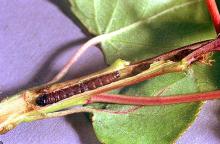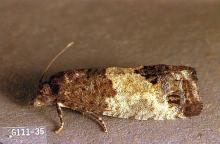Spilonota ocellana
Pest description and crop damage Adults are grayish moths about 0.4 inch long with a wide light-colored band on each forewing. Larvae are chocolate-brown with black heads, and up to 1 inch long. The eyespotted bud moth does not usually require control on apples.
Biology and life history Larvae spend the winter in a cocoon on the bark in the crotches of small-diameter limbs. They become active around budbreak and feed on leaves and buds, webbing together leaves and feeding within these nests. After feeding, they pupate within the nest and adult moths emerge in early to mid-summer. Eggs are laid on the lower surface of leaves. Larvae emerge and feed on the lower leaf surface until early August, at which time they construct their overwintering cocoons (hibernacula).
Sampling and thresholds Look for larvae in nests of webbed-together leaves in the spring.
Management-chemical control: HOME USE (note: treatments rarely necessary)
Spring and summer
- carbaryl-Highly toxic to bees.
Management-chemical control: COMMERCIAL USE (note: treatments rarely necessary)
Spring and summer
- methoxyfenozide (Intrepid 2F) at 8 to 16 fl oz/A in up 100 gal water per application. Apply once or twice against overwintering larvae. Do not exceed 64 fl oz/A per growing season. REI 4 hr. PHI 14 days. [Group 18]
- novaluron (Rimon) at 20 to 40 fl oz/A in 100 gal water per application. Apply at beginning of egg hatch. Do not use Rimon in alternate row middle application patterns since this method will result in off-timing application and poor performance. Do not apply more than four applications or more than 150 fl oz/A per growing season. Do not allow Rimon to drift on grapes as leaf spotting may occur. REI 12 hr. PHI 14 days. [Group 15] [ovicide]
- tebufenozide (Confirm 2F) at 20 fl oz/A in up to 100 gal water per application. Do not apply more than 120 fl oz/A per growing season. REI 4 hr. PHI 14 days. [Group 18A]



